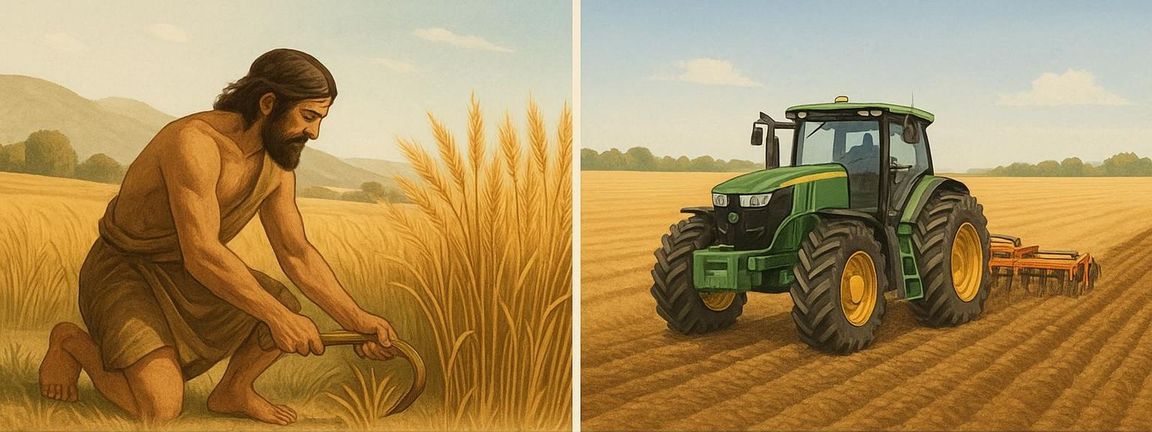Agriculture, also known as farming, is the production of food, fiber, animal feed and other goods by harvesting plants and animals. Agriculture is now practiced throughout the world and is an essential part of human civilization and its history dates back thousands of years. Here's a timeline of the history of agriculture:
Invention of Agriculture (10,000 BCE)
Agriculture was invented during the Neolithic era, also known as the New Stone Age. The birthplace of agriculture is believed to be the Fertile Crescent, a region stretching from the eastern Mediterranean coast to the Persian Gulf. The eight Neolithic crops were emmer wheat, einkorn wheat, peas, lentils, bitter vetch, hulled barley, chickpeas, and flax.
Irrigation and Canal Networks (4000–3000 BCE)
Irrigation systems were developed in Egypt and Mesopotamia to help regulate the flow of rivers and ensure the availability of water for crops. One of the most impressive irrigation systems developed during this time was the qanat, an underground canal used to tap into underground streams.
Improvements in Farming Implements (3000–1000 BCE)
During the Bronze Age, advanced metalworking techniques led to the development of stronger farming implements. This allowed for more efficient tilling of the soil and increased agricultural productivity. The moldboard plow and crop rotation were also introduced during this time.
British Agricultural Revolution (1700s–1800s)
The British Agricultural Revolution was a period of significant agricultural productivity in Britain. New methods of crop rotation and cultivation of previously unused land were introduced, and new crops such as the turnip were grown.
Evolution of Equipment and Technology (1800s–1900s)
The introduction of agricultural equipment and machinery such as tractors and mechanical harvesters helped to increase efficiency and productivity on the farm. More recently, GPS‑guided tractors, drones, and sensors have been developed to monitor soil and crop health. Hybrid seeds have also been created through genetic engineering.
Sustainable Agriculture (1900s–present)
Sustainable agriculture is a method of farming that promotes environmentally‑friendly and socially‑responsible practices. Techniques include crop rotation, cover cropping, and integrated pest management, as well as efforts to reduce the use of pesticides.
Agricultural Biotechnology (1900s–present)
Agricultural biotechnology involves the use of genetic engineering to improve crop yields and enhance plant traits. Genetically modified organisms (GMOs) have been developed, but there is ongoing debate about their potential health and environmental risks.
Agricultural Policy (1900s–present)
Government subsidies and regulations have been used to support agricultural development and protect labor, the environment, and animal welfare. Refrigerated transport companies are also essential for the transport of perishable goods.
The Future of Agriculture (present‑future)
The future of agriculture will likely involve the continued development and use of emerging technologies and innovations, such as robotics and artificial intelligence. Precision agriculture, which uses data and analytics to optimize crop yields and minimize inputs, will also become more important. Vertical farming, which involves growing crops in stacked layers, and agroforestry, which integrates trees and shrubs into agricultural landscapes, may also become more prevalent.
Bridging Past & Future: How Modern Financing Fuels the Next Ag Revolution
History proves that each leap in farm productivity—from the first wooden plow to today’s satellite‑guided planters—depends on timely capital. Yet replacing a worn tractor or adding an autonomous sprayer still ties up six or seven figures in cash. That’s where specialized agriculture‑equipment financing becomes a strategic tool rather than a cost line.
Crest Capital structures fixed‑rate loans and leases that match an asset’s productive life, so agribusinesses retain liquidity for seed, land rents, or the next land auction—without compromising on the technology that drives yield. We approve hard‑collateral deals up to $250,000 with a simple one‑page application; larger or multi‑unit fleets receive dedicated analyst review. Either path shields working capital while locking in predictable payments that survive commodity‑price swings.
Rapid funding also lets producers capture early‑order discounts from dealers or secure depreciable assets before the calendar flips. Pair a loan with the Section 179 deduction and you can deduct the full purchase price in the year you place the asset in service, slashing taxable income. Run the numbers with our equipment payment calculator; many growers find the after‑tax cost per acre falls below the projected yield bump from precision guidance.
Whether you’re retrofitting a fleet with autosteer kits, scaling a greenhouse with LED arrays, or automating grain handling, flexible financing keeps innovation on‑farm instead of on hold. The next milestones in this timeline will be written by growers who invest ahead of the curve. Crest Capital is here to provide the funding when opportunity and season collide.
Agriculture Equipment Financing FAQ
Can Crest Capital finance used or private‑party farm equipment?
Yes. Late‑model tractors, combines, and implements purchased from dealers or private sellers qualify if they meet age and hour guidelines and retain strong collateral value.
How quickly can I get approved and funded?
For complete applications under $250k, credit decisions often arrive within hours; e‑docs and vendor payment typically follow in one business day so you can put equipment to work immediately.
Can I combine Section 179 tax savings with an equipment loan?
Absolutely. Financing preserves cash while still allowing the full Section 179 deduction in the year the equipment is placed in service—effectively letting tax savings subsidize part of your payments.
Can payments be structured around harvest seasons?
Yes. Seasonal, skip‑payment, or annual structures let you align installments with crop‑cycle cash flow so payments are minimal during off‑season months.
Conclusion
Agriculture has played a significant role in human civilization, allowing us to settle in one place and produce the food we need to survive. However, modern agriculture faces numerous challenges, including sustainable practices, biotechnology controversies, and policy implications. Agriculture is a crucial industry that will continue to shape human civilization in the future.




